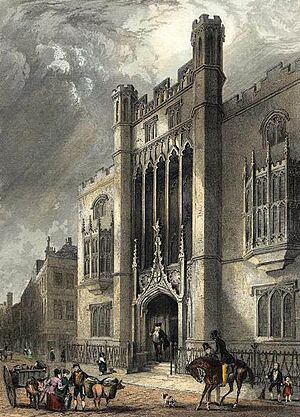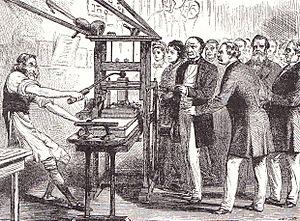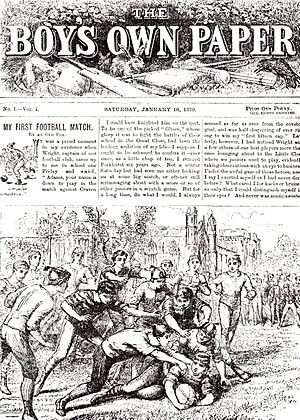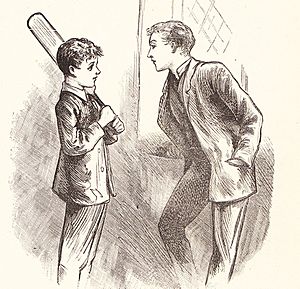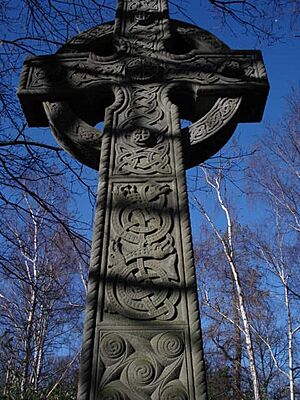Talbot Baines Reed facts for kids
Quick facts for kids
Talbot Baines Reed
|
|
|---|---|
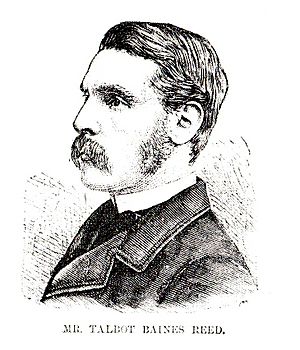
Pen-and-ink portrait of Reed, around 1880
|
|
| Born | 3 April 1852 Hackney, London, England |
| Died | 28 November 1893 (aged 41) Highgate, London, England |
| Occupation | Writer, Typefounder |
| Genre | Children's literature |
| Signature | |
Talbot Baines Reed (born April 3, 1852 – died November 28, 1893) was an English writer. He was famous for his stories for boys, especially those set in schools. These "school stories" became very popular and were read for many years. His most well-known book is The Fifth Form at St. Dominic's.
Reed wrote many stories for The Boy's Own Paper (B.O.P.), a popular magazine for young people. Most of his stories first appeared there. Besides writing, Reed also worked in his family's business. They were "typefounders," which means they made the metal letters used for printing books and newspapers. Reed even wrote an important book about this, called History of the Old English Letter Foundries.
Talbot's father, Charles Reed, was a successful printer in London. He later became a Member of Parliament (MP), which is like a government representative. Talbot went to the City of London School. At 17, he joined his family's printing business. His writing career began in 1879 when The Boy's Own Paper started.
The Reed family was very religious and active in the Congregational Church. They also did a lot of charity work. However, Talbot Reed did not use his stories to preach or give moral lessons. He believed that school stories should be fun and exciting. Reed understood boys well and created characters that felt real. This made his stories popular for many generations. Other writers often copied his style in their own school stories.
In 1881, after his father passed away, Reed took over the family business. He also worked on his big history book, which was published in 1887. Besides writing for B.O.P., Reed wrote articles and book reviews for his cousin's newspaper, the Leeds Mercury. He also helped start the Bibliographical Society, a group that studies books and printing. He was also a trustee for his family's charities. All this hard work might have made him sick. After being ill for most of 1893, Reed died in November of that year, when he was only 41. People remembered him for his great children's stories and for his important work on the history of typefounding.
Contents
Reed's Family History
The Reed family came from a long line of people, including a colonel in Oliver Cromwell's army. They lived in Maiden Newton, Dorset, before moving to London in the late 1700s. Talbot Reed's grandfather, Andrew Reed (1787–1862), was a minister in the Congregational Church. He started several charities, like an orphanage and a hospital. He also wrote hymns, and some of his songs are still sung today.
Andrew Reed had five sons. His third son, Charles Reed (1819–81), was Talbot's father. Charles worked in the wool industry in Leeds, Yorkshire. There, he met Edward Baines, who owned the Leeds Mercury newspaper. The Baines family was well-known for public service. Charles Reed married Edward Baines's daughter, Margaret, in 1844. By then, Charles had started his own printing business in London.
The family settled in Hackney, London. Charles was very active in public life and religious matters, especially in education. He became a member and chairman of the London School Board. He also helped create the Congregational Church Board of Education. From 1868 to 1881, he was one of Hackney's MPs. Charles and Margaret had five sons. Their third son, Talbot Baines, was born on April 3, 1852. As Charles's business grew, he bought a "type foundry" called Thorowgood in Fann Street, City of London, in 1861.
Talbot's Early Life
Talbot Baines Reed grew up in a happy home. His father, Charles, was very religious and believed that outdoor sports were good for boys. This home life suited Talbot's personality. Talbot first went to Priory House School in Clapton. In 1864, he became a day student at the City of London School. This school was quite new, started in 1837.
Talbot's older brother, Charles junior, had been very successful at the school. He was captain of the school and a leader in cricket and football. Talbot also did well, especially in sports. A friend described him as "full of life and vigour." He was strong, fearless, and always stood out. Reed later joked that his only academic success was winning "the comfortable corner desk near the fire" for being last in Math. But actually, he was very good at French, Greek, and Latin. He even competed for a Latin prize. One of his classmates was H. H. Asquith, who later became the British Prime Minister.
Even though he was good at academics, Reed did not go to university like his brother. Instead, in 1869, he left school to join the family printing business, known as Sir Charles Reed & Sons. This began his lifelong connection with printing. However, he still found time for many other interests. He once walked 53 miles (85 km) from London to Cambridge twice! Reed was a good swimmer and even won a medal for saving a cousin from drowning. He was also a talented pianist and artist. He used his artistic skills to create a family magazine called The Earlsfield Chronicle, which he mostly wrote himself. This magazine was only for his family and included serious articles, funny poems, and cartoons.
Printer and Typefounder
Reed sometimes joked that his work at the family business was "boring." But he was actually very keen on it and worked hard to learn everything. Early in his career, he met William Blades, a famous printer. Blades taught Reed a lot about printing and typefounding. Even though Reed was still new to the field, Blades asked him to help organize a big exhibition. This exhibition celebrated 400 years since William Caxton printed his first book in England.
The exhibition was held in the summer of 1877 in South Kensington. William Gladstone, who was a former and future prime minister, opened it. The exhibition showed Caxton's printed works and many other examples of printing from over the years. Reed wrote an essay for the exhibition's catalog called "The Rise and Progress of Type-Founding in England." The exhibition was very popular and supported by many important people in printing and books.
Sir Charles Reed, Talbot's father, died in 1881. A few months later, Talbot's older brother Andrew left the business due to illness. So, at 29, Talbot became the main director of the Fann Street business. He held this job until he died. In 1878, Reed started working on a history of typefounding in England. This project took him almost ten years. The book, called History of the Old English Letter Foundries, was published in 1887. It became a very important book on the subject. It had 21 chapters with examples of typefaces and symbols used over four centuries. In 1887, Reed also created a new and improved sample book for the Fann Street foundry, showing many new type designs.
Because he was an expert, Reed was often asked to give talks to learned groups. He spoke about "Old and New Fashions in Typography" to the Royal Society of Arts in 1890. After Blades died in 1890, Reed helped publish Blades's unfinished book, Pentateuch of Printing. Reed's foundry also made special typefaces, like the Golden Type for William Morris's Kelmscott Press in 1890. Reed even convinced Morris to give a lecture for the Bibliographical Society in 1893.
The Boy's Own Paper
The Reed family had strong ties to The Religious Tract Society (RTS). This group was started in 1799 to publish Christian materials. Talbot's grandfather, Andrew Reed, was at the Society's first meeting. Charles Reed and his oldest son, Charles junior, were also active members. In 1878, a group from RTS suggested publishing "a magazine for Boys" every week for one penny. The Society wanted to offer a good alternative to the "cheap and sensational" magazines boys were reading. Even though they worried about the cost, they decided to go ahead. The first issue of The Boy's Own Paper came out on January 18, 1879.
Reed did not have much writing experience at the time. But his father and brother asked him to write for the new magazine, and he was excited to do it. Before this, he had only written stories for his family magazine and an article called "Camping Out" for another youth magazine in 1875. For the first issue of B.O.P., Reed wrote a school story called "My First Football Match." It appeared on the front page and was signed "by An Old Boy." The story was very popular, and readers wanted more about "Parkhurst," the school in the story. Reed wrote more tales, like "The Parkhurst Paper Chase" and "The Parkhurst Boat Race."
In the first year of B.O.P., Reed wrote many articles and stories. He joined other famous writers like G. A. Henty and Jules Verne. A well-known artist named Edward Whymper also drew pictures for the magazine. Reed continued to write for B.O.P. for the rest of his life. Almost all his fiction was first published there. His commitment to B.O.P. slowed down his work on his History of the Old English Letter Foundries. He also started writing regular columns and book reviews for the Leeds Mercury, which was edited by his cousin.
The 1880s were a time of growing wealth in England. More and more middle-class families were sending their sons to boarding schools. George Hutchison, the editor of B.O.P., thought these schools would be perfect for stories. He wanted stories where a boy hero could show good values and strength. Reed had not gone to a boarding school himself. But his skill in writing short school stories convinced Hutchison that Reed was the right person to write a long story series.
Famous School Stories
Reed's first long school story for The Boy's Own Paper was The Adventures of a Three-Guinea Watch. It ran in 19 parts from October 1880 to April 1881. The story followed a schoolboy's pocket watch as it traveled through school, university, and finally to India. The school, "Randlebury," was probably based on information Reed got from friends who went to Radley. The story was a success, so the B.O.P. editors asked Reed to write a longer and more ambitious work.
This led to The Fifth Form at St. Dominic's, which became Reed's most popular and important story. It was published in 38 parts. Each part was a complete story within a larger plot. This was the first of many school stories by Reed, all published in B.O.P.. He used the boarding school setting again in The Willoughby Captains (1883–84), The Master of the Shell (1887–88), The Cock-House at Fellsgarth (1891), and Tom, Dick and Harry (1892–93). The term "Cock-House" means the champion house within the school. English schools often divide students into "houses" that compete, especially in sports.
Reed also wrote My Friend Smith (1882–83), which was set in a different kind of school for "backward and troublesome" boys. However, his boarding school stories were the ones that lasted and became the standard for school stories for many decades. All his serial stories were quickly published as books. They were reprinted for new generations of boys until the 1950s. Other writers copied Reed's style for the next 50 years. Historian Isabel Quigly says that "Reed was a better writer than his followers."
In 2004, historian Jeffrey Richards described Reed's work as a mix of earlier school story styles, but with a lively and easy-to-read writing style. Reed thought that earlier school stories were too much like religious lessons. He wanted to write something more "manly." Many of the events and characters Reed created in St. Dominic's became common in his later stories and in those written by others. Quigly lists common features like the stolen exam paper, the innocent boy wrongly accused, boating accidents, rivalries between groups, and strong friendships. Adult characters were often simple types: a headmaster called "the Doctor," a funny French teacher, a popular sports teacher, and humorous staff. Reed created a tradition where fictional boarding schools had these kinds of characters. They were often described with "dark passages, iron bedsteads, scratched desks, chilly dormitories and cozy, shabby studies." Quigly suggests that Reed's stories were successful because they were more about people than just about school. John Sime of the RTS said that the boys in Reed's stories felt real, with "just that spice of wickedness... without which a boy is not a boy."
Personal Life and Other Activities
In 1876, Reed married Elizabeth Greer. She was the daughter of Samuel MacCurdy Greer, a judge and former MP from Ireland. Their first child, a daughter, died as a baby. But they later had three healthy children: Charles (born 1879), Margaret (born 1882), and Talbot (born 1886). Reed loved his connection to Ireland. The family often spent their yearly holidays by Lough Swilly in County Donegal.
Reed was always busy. He disliked people who only worked from nine to five and did nothing else. Besides his demanding work at the foundry and his writing, he helped manage the charities his grandfather Andrew Reed had started. He was also a deacon at his local Congregational Church. In 1892, he helped found the Bibliographical Society and was its first honorary secretary.
Reed was physically active and energetic. He keenly followed his old school's sports teams. He even wrote to the school once, worried that they seemed to have lost their enthusiasm for football and cricket. He had a busy social life, attending old boys' dinners and being a member of two London clubs. In politics, Reed was a Liberal, though he disagreed with Gladstone's policy on Irish Home Rule. His busy and fulfilling life had its sad moments. After losing his baby daughter, his younger brother Kenneth drowned in Ireland. In 1883, his older brother, The Rev. Charles Reed, who was like a "father confessor" to him, died after a fall in Switzerland.
Death and Legacy
Reed was generally healthy. However, in early 1893, his heavy workload started to affect him. In January, he went to Ireland for a long stay, hoping to regain his strength. He returned to his duties in May, but later that summer, he became very ill with what was called "consumption" at the time. It was probably pulmonary tuberculosis. He stepped down as secretary of the Bibliographical Society and went back to Ireland. Even though he was mostly indoors, he kept writing his weekly column for the Leeds Mercury. He also finished his last novel, Kilgorman. Letters to friends showed he was still in good spirits and hoped to get better.
However, his condition worsened, and he was advised to return home for urgent medical care. Back in London, he wrote his last piece for the Mercury. He died at his home in Highgate on November 28, 1893, at the age of 41. He was buried in Abney Park Cemetery, next to his father and grandfather.
Many people paid tribute to Reed. Joseph Sime said that "the boys of the English-speaking world" had "lost one of their best friends." Sime wrote that Reed truly understood young people: "He possessed in himself the healthy freshness of heart of boyhood... and could place himself sympathetically at the boy's standpoint in life." Boys and their families visited Reed's grave for many years. He died a wealthy man, but he had given the rights to his books to the Religious Tract Society for a small fee long before his death.
Young P.G. Wodehouse, a famous writer, was one of Reed's regular readers. He especially loved the school stories. Wodehouse's biographer, Benny Green, said that Reed influenced Wodehouse, especially with The Willoughby Captains. Green also agreed that none of Reed's followers could match his storytelling skills. Quigly summarized Reed's gift to future school story writers: he changed the "shapeless, long-winded, garrulous and moralistic school story" into something popular and readable. This style was followed by all who came after him. Reed himself shared his life's principles in a letter to a new Boys' Club: "The strong fellows should look after the weak, the active must look after the lazy, the merry must cheer up the dull, the sharp must lend a helping hand to the duffer. Pull together in all your learning, playing and praying."
Reed's grave in Abney Park eventually got a memorial stone for his family. It was a Celtic cross, showing their Irish connections. It was made by the O'Shea brothers' company. Reed's biographer, Stanley Morison, believes Reed's most important legacy is his History of the Old English Letter Foundries. However, Jack Cox, a historian of B.O.P., says that the school stories first published in the magazine are the writer's true memorial.
After Reed's death, Elizabeth Reed agreed to give his large personal library to the St Bride Foundation Institute. This collection now forms part of the St Bride Library. The books and collection from Reed's company, the Fann Street Foundry, went to its later owner, Stephenson Blake, and then to the Type Museum collection.
Fiction
- Most of Reed's school stories and other fiction first appeared in The Boy's Own Paper.
Non-fiction
- History of the Old English Letter Foundries (1887)
Images for kids
See also
 In Spanish: Talbot Baines Reed para niños
In Spanish: Talbot Baines Reed para niños



